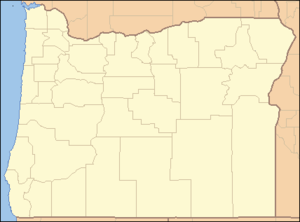Wallowa River
| Wallowa River | |
|
Wallowa River at Wallowa, Oregon
|
|
| Name origin: A Nez Perce word for a triangle of stakes forming part of a fish trap | |
| Country | United States |
|---|---|
| State | Oregon |
| County | Wallowa and Union |
| Tributaries | |
| - left | Lostine River, Minam River |
| Source | Confluence of the east and west forks of the Wallowa River |
| - location | about 1 mile (1.6 km) south of Wallowa Lake, Wallowa County, Oregon |
| - elevation | 4,499 ft (1,371 m) |
| - coordinates | 45°16′28″N 117°12′42″W / 45.27444°N 117.21167°W |
| Mouth | Grande Ronde River |
| - elevation | 2,316 ft (706 m) |
| - coordinates | 45°43′31″N 117°47′09″W / 45.72528°N 117.78583°WCoordinates: 45°43′31″N 117°47′09″W / 45.72528°N 117.78583°W |
| Length | 55 mi (89 km) |
| Basin | 950 sq mi (2,460 km2) |
| Discharge | for Wallowa |
| - average | 610 cu ft/s (17 m3/s) |
| - max | 4,640 cu ft/s (131 m3/s) |
| - min | 89 cu ft/s (3 m3/s) |
The Wallowa River is a tributary of the Grande Ronde River, approximately 55 miles (89 km) long, in northeastern Oregon in the United States. It drains a valley on the Columbia Plateau in the northeast corner of the state north of Wallowa Mountains.
The river begins at the confluence of its east and west forks, which rise in southern Wallowa County, in the Eagle Cap Wilderness of the Wallowa–Whitman National Forest. It flows generally northwest through the Wallowa Valley, past the communities of Joseph, Enterprise, and Wallowa. It receives the Minam River from the at the hamlet of Minam. Continuing north another 10 miles (16 km), it joins the Grande Ronde along the Wallowa–Union county line about 10 miles (16 km) north-northeast of Elgin and about 81 miles (130 km) from the larger river's confluence with the Snake River.
The Wallowa Valley was home to Chief Joseph's band of the Nez Perce Tribe. Chief Joseph asked the first white settlers to leave when they arrived in 1871. The U.S. government expelled the tribe and seized their property and livestock in 1877, when non-Indian farmers and ranchers wanted to settle the fertile Wallowa valley. The tribe was barred from returning to their homeland by the government after repeated petitions. The tribal members were shipped in unheated box cars to Indian Territory (now Oklahoma) to be placed in a prisoner of war camp never to see their home again.
...
Wikipedia


